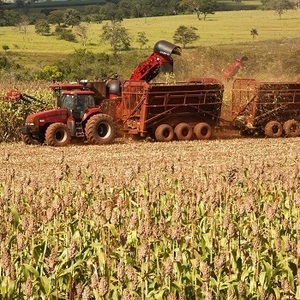Ceres releases Q2 financials, reports progress with sweet sorghum

Ceres Inc.
April 16, 2013
BY Erin Krueger
Ceres Inc. has released financial results for the second quarter of its 2013 fiscal year, which ended Feb. 28. The company also provided an operational update, noting progress with its sweet sorghum and switchgrass varieties.
According to information released by Ceres, commercial harvests of its newest sweet sorghum hybrids have started in Brazil, with the majority of hectares expected to be harvested within the next few weeks. During a call to discuss the financial results, Ceres President and CEO Richard Hamilton discussed how the Brazilian growing season has progressed so far. The company is working with more than 30 mills and major growers in Brazil that represent approximately 30 percent of Brazil’s sugarcane crush capacity. Approximately 3,000 hectares (7,413 acres) of Ceres’ sweet sorghum is being cultivated in Brazil during the current growing season.
With a few exceptions, Hamilton said the growing season has been favorable. “We are seeing what I would describe as the normal variation in conditions during the season and from field to field, and this has allowed ourselves and the majority of our customers to focus our attention on how our products are performing, as well as on the overall economics of sweet sorghum cultivation and processing,” he said.
In terms of performance and yield, Hamilton said the Ceres’ varieties appear to be head of those developed by competitors. “As we approach harvest our hybrids are visibly taller than competitors’ at multiple locations where side-by-side comparisons are available,” he said.
Advertisement
Ceres has also successfully validated its high-sugar trait in noncommercial types of sorghum. “Initial trials have demonstrated significant increases in incremental sugar concentration, increased juiciness and greater sucrose purity,” Hamilton said.
According to Ceres, the company has also demonstrated higher-than-expected drought tolerance results in switchgrass. In field evaluations, plants with Ceres drought tolerance genes maintained 100 percent biomass yield levels under water deficits of approximately 50 percent. Hamilton also noted that the genes provided an overall yield increase when the plants were exposed to less severe drought conditions.
“For the cellulosic markets, our breeders have been making steady progress in improving switchgrass, high-biomass types of sorghum and miscanthus for increasing yields and agronomic traits,” Hamilton said. “The results from last season’s breeding cycle have again shown exceptional yield and performance improvements across our energy crops.”
Advertisement
During the three months ended Feb. 28, Ceres was awarded six U.S. patents related to commercial product, methods for improving plants and plant parts, and compositions of matter for protein-encoding DNA sequences.
Regarding financial results, total revenues for the second fiscal quarter of 2013 were $1 million, a decrease compared to the $1.3 million reported for the same period of 2012. Ceres attributes the decrease to lower collaborative research and government grant revenues as well as lower seed sales.
Cost of product sales increased to 2.3 million for the quarter, compared to $500,000 for the same quarter of last year. Research and development expenses were $4.4 million for the quarter, a decrease when compared to the $5 million for the same period of 2012. Selling, general and administrative expenses increased to $3.4 million for the quarter, up from $2.8 million for second fiscal quarter of 2012.
Ceres reported a net loss of $9.87, for 36 cents per share, for the quarter. A net loss of $6.83 million, or $2.48 per share, was reported for the same period of 2012.
Related Stories
The USDA significantly increased its estimate for 2025-’26 soybean oil use in biofuel production in its latest World Agricultural Supply and Demand Estimates report, released July 11. The outlook for soybean production was revised.
The U.S. Energy Information Administration maintained its forecast for 2025 and 2026 biodiesel, renewable diesel and sustainable aviation fuel (SAF) production in its latest Short-Term Energy Outlook, released July 8.
XCF Global Inc. on July 10 shared its strategic plan to invest close to $1 billion in developing a network of SAF production facilities, expanding its U.S. footprint, and advancing its international growth strategy.
U.S. fuel ethanol capacity fell slightly in April, while biodiesel and renewable diesel capacity held steady, according to data released by the U.S. EIA on June 30. Feedstock consumption was down when compared to the previous month.
XCF Global Inc. on July 8 provided a production update on its flagship New Rise Reno facility, underscoring that the plant has successfully produced SAF, renewable diesel, and renewable naphtha during its initial ramp-up.
Upcoming Events










